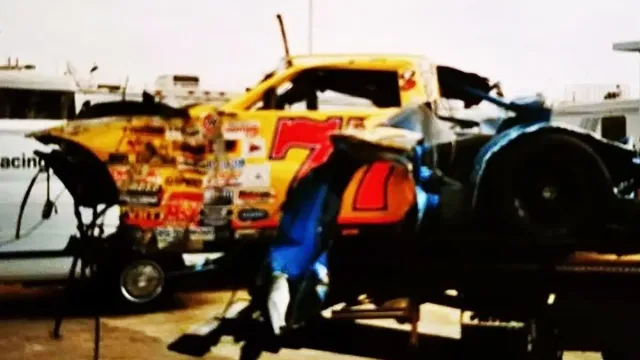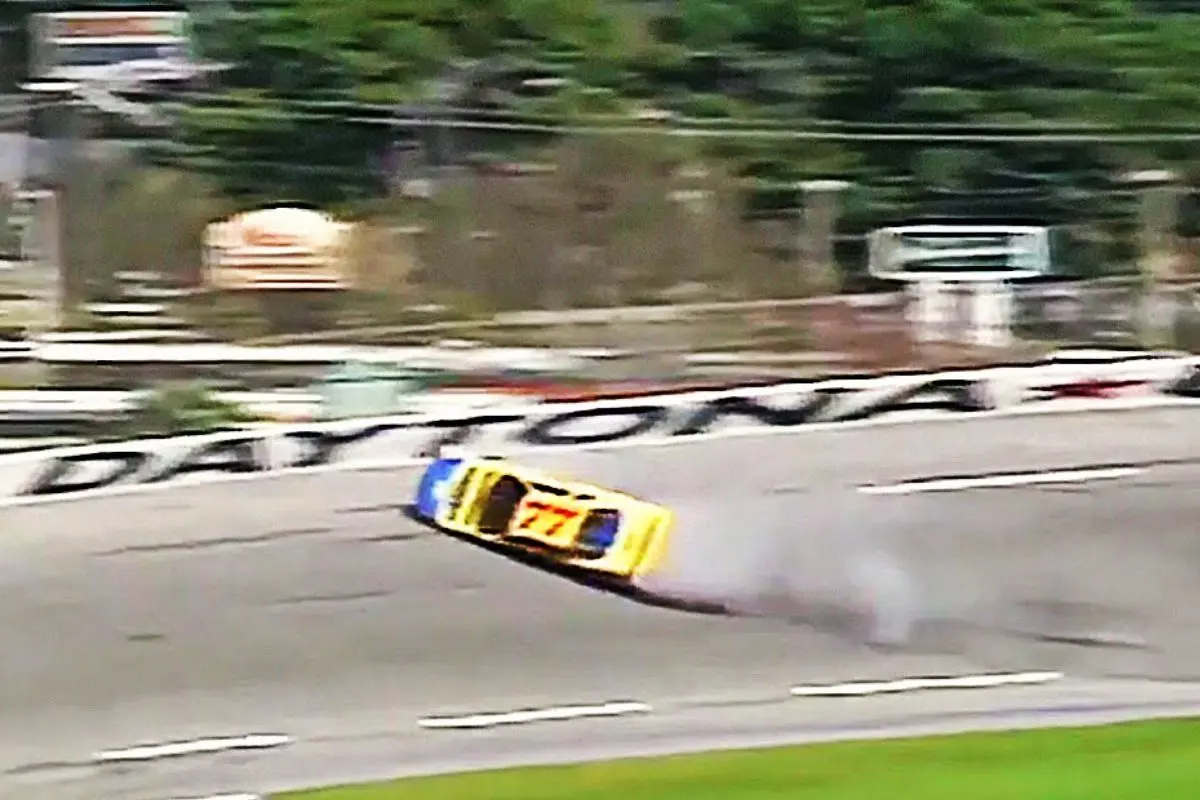Andy Farr’s near-fatal Daytona wreck shocked the NASCAR world in 1994, leaving fans wondering how he survived such a violent crash. But his story is just one part of a tragic Speedweeks that saw back-to-back fatalities. The terrifying events raised serious questions about NASCAR’s safety. What happened during that fateful week? And how did Andy Farr walk away when others didn’t?
Andy Farr’s Daytona Crash
On February 10, 1994, Andy Farr faced a life-altering moment during qualifying for the ARCA 200 race at Daytona International Speedway. The promising driver’s first attempt to race on one of NASCAR’s most famous tracks ended in a horrifying crash. As Farr entered Turn 4, he lost control of his car, causing it to spin wildly. In his attempt to regain control, he over-corrected, triggering a violent series of flips that ultimately sent his vehicle barreling into the concrete wall.
The impact was catastrophic, leaving a massive hole in the concrete wall and destroying nearly 75 feet of the catch fencing. Witnesses were stunned by the ferocity of the crash, describing it as one of the most violent incidents ever seen at Daytona. Farr’s car disintegrated upon impact, leaving debris scattered across the track. It was a chilling moment that highlighted the inherent dangers of high-speed racing.

Neil Bonnett’s Legacy Saves Andy Farr
Despite the terrifying nature of the crash, Andy Farr survived, an outcome many called miraculous. The driver sustained a broken sternum and a bruised heart—injuries considered minor compared to the severity of the crash. Farr himself credited his survival to the advanced safety belt system he was using, which had been designed by NASCAR veteran Neil Bonnett.
Tragically, Bonnett would lose his life in a similar accident just days later, underscoring the fine line between life and death in motorsports. Reflecting on the crash, Farr acknowledged that the five-point harness likely saved his life. “Without it, I wouldn’t be here today,” he stated. His survival stood in stark contrast to the multiple fatalities that marred the same Speedweeks, making his story one of hope amid tragedy.
1994 Daytona Speedweeks: Back-to-Back Fatalities Shake Daytona Speedway
The 1994 Daytona Speedweeks were overshadowed by an unprecedented wave of tragedy. Just one day after Farr’s crash, Neil Bonnett—a beloved veteran of the sport—lost his life in a practice session at Daytona. Three days later, rising star Rodney Orr suffered a fatal crash during a practice run. These back-to-back incidents devastated the NASCAR community and raised serious questions about the safety measures in place at the time.
Farr’s survival offered a glimmer of hope during this dark period. While Bonnett and Orr’s deaths highlighted the deadly risks of the sport, Farr’s near-fatal accident underscored the importance of evolving safety technologies. The tragedies of 1994 would later be recognized as a turning point in NASCAR’s approach to driver safety.
Mark Martin Reflects on Dangerous 1994 Tire Race
A significant factor contributing to the dangers of the 1994 season was the ongoing tire war between Hoosier and Goodyear. Both companies competed fiercely to produce the fastest tires, often at the expense of safety. Hoosier tires, known for their softer compound, were particularly prone to failure under extreme conditions.
Mark Martin, one of NASCAR’s most respected drivers, later remarked, “I’m really proud I lived to talk about the ’94 tire war. It’s not worth it, man.” His words captured the widespread concern among drivers about the dangers posed by the ultra-competitive environment.
After multiple incidents linked to tire failures, including the fatal crashes of Bonnett and Orr, NASCAR took decisive action. Teams were allowed to switch to Goodyear tires for the Daytona 500, a move that marked the beginning of the end for Hoosier in NASCAR. By 1997, Goodyear became the sole tire supplier, ensuring a safer and more standardized racing environment.
Technical Insights: The Science Behind Surviving High-Impact Crashes
Farr’s crash provided valuable insights into the dynamics of high-speed racing accidents. Experts noted that the violent flipping of his car, while terrifying to watch, may have actually helped dissipate the energy of the impact. By spreading the force of the crash over multiple points of contact, the likelihood of a fatal injury was reduced.
The incident also emphasized the critical role of vehicle design and safety equipment. From the reinforced roll cages to the five-point harness system, every element of Farr’s car played a role in his survival. Racing safety experts pointed to the crash as a stark reminder of the importance of continuous innovation in protective technologies.
The Evolution of NASCAR Safety Innovations
The aftermath of Andy Farr’s crash, along with the tragedies of 1994, spurred NASCAR to adopt significant safety improvements. One of the most notable changes was the introduction of roof flaps, designed to prevent cars from going airborne during high-speed incidents. These flaps, first implemented in 1994, became a standard feature in NASCAR vehicles.
Other innovations followed in the years to come. The HANS device, introduced in 2001, became mandatory after the tragic death of Dale Earnhardt in 2001. This device dramatically reduced the risk of fatal head and neck injuries. Additionally, NASCAR invested heavily in developing safer barriers, such as the Steel and Foam Energy Reduction (SAFER) barriers, to minimize the impact of crashes.
Farr’s survival was a pivotal moment that helped pave the way for these advancements. His story became a powerful example of how safety technologies could save lives and prevent further tragedies.
Remembering the Legacy: How 1994 Shaped Modern NASCAR Safety Standards
Andy Farr’s crash and survival left an indelible mark on NASCAR’s history. His story is often cited as a turning point in the sport’s approach to safety, symbolizing the critical importance of continuous innovation in protective measures.
The events of 1994, though tragic, served as a wake-up call for NASCAR and the broader motorsports community. The deaths of Neil Bonnett and Rodney Orr, coupled with Farr’s near-fatal crash, underscored the urgent need for improved safety protocols. Today, NASCAR’s commitment to driver safety is evident in the numerous advancements made since that fateful year.
For Farr, his survival was not just a personal victory but a testament to the resilience of the human spirit and the power of technology to protect lives. As the NASCAR community remembers the tragedies of 1994, it also celebrates the progress made in ensuring that such losses become increasingly rare.
New in Brief: Andy Farr’s Near-Fatal Daytona Wreck
Andy Farr’s near-fatal Daytona Wreck in 1994 was a turning point for NASCAR safety, highlighting both the sport’s dangers and the progress made to protect drivers. His miraculous survival contrasted sharply with the tragic back-to-back fatalities of Neil Bonnett and Rodney Orr. These events sparked a wave of safety reforms, including new standards for car designs and stricter regulations. Today, NASCAR is a much safer sport, thanks to those painful lessons.
ALSO READ: NASCAR’s Last 1949 Dirt Track Left to Rot: The Occoneechee Speedway Story



